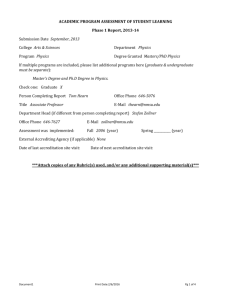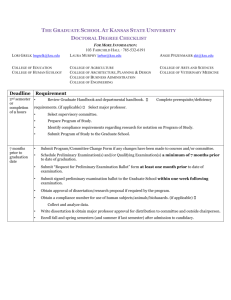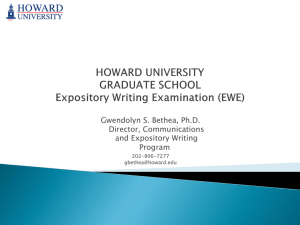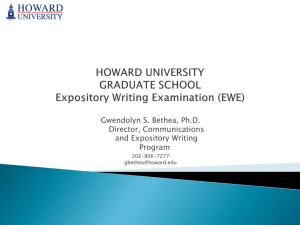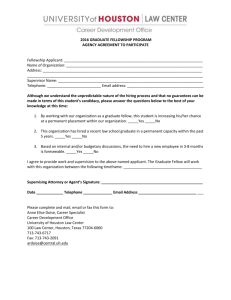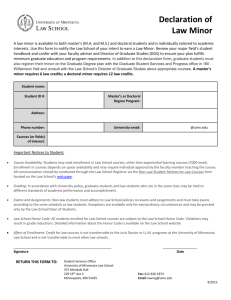Students will be able to solve advanced problems in the general
advertisement
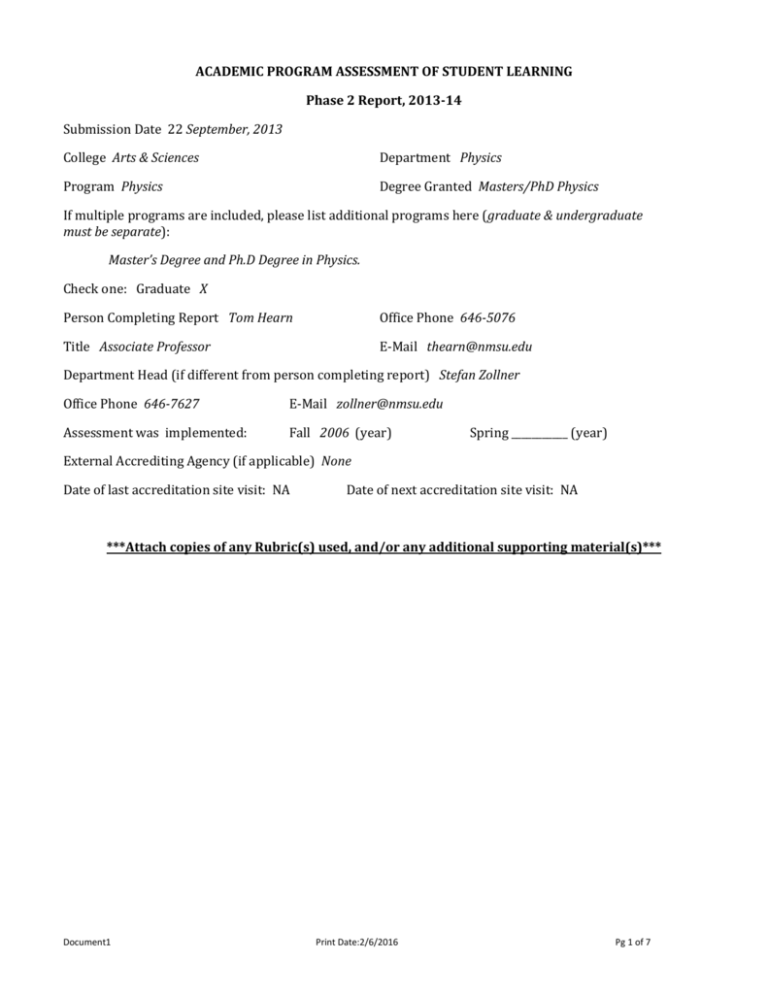
ACADEMIC PROGRAM ASSESSMENT OF STUDENT LEARNING Phase 2 Report, 2013-14 Submission Date 22 September, 2013 College Arts & Sciences Department Physics Program Physics Degree Granted Masters/PhD Physics If multiple programs are included, please list additional programs here (graduate & undergraduate must be separate): Master’s Degree and Ph.D Degree in Physics. Check one: Graduate X Person Completing Report Tom Hearn Office Phone 646-5076 Title Associate Professor E-Mail thearn@nmsu.edu Department Head (if different from person completing report) Stefan Zollner Office Phone 646-7627 E-Mail zollner@nmsu.edu Assessment was implemented: Fall 2006 (year) Spring ___________ (year) External Accrediting Agency (if applicable) None Date of last accreditation site visit: NA Date of next accreditation site visit: NA ***Attach copies of any Rubric(s) used, and/or any additional supporting material(s)*** Document1 Print Date:2/6/2016 Pg 1 of 7 PROGRAM OVERVIEW Briefly summarize your assessment implementation and findings from the prior year, or prior years. How did past assessment activities and/or findings affect your assessment for the current academic year? If applicable, discuss any past curricular or instructional developments/changes that influenced this assessment – e.g. you implemented changes based on assessment findings, and this is a reassessment to determine impact of those changes; your previous assessment brought to light new/additional questions that you sought to addressed through this assessment; your previous assessment indicated no changes were needed, so you are assessing a different outcome this year; etc. NMSU Mission: New Mexico State University is the state’s land-grant university, serving the educational needs of New Mexico’s diverse population through comprehensive programs of education, research, extension education, and public service. Academic Program Mission: The academic mission of Physics at New Mexico State University is to offer graduate degrees in physics to prepare our graduating students for careers in industry, academics, and government research. Academic Program Goals: To provide students with a fundamental background in graduate physics and geophysics and to teach them to produce high-quality research results in their field. Academic Program Objectives: Objective 1: Competitiveness. Graduates are competitive in internationally-recognized academic, government and industrial environments; Objective 2: Adaptability. Graduates exhibit success in solving complex technical problems in a broad range of disciplines subject to quality engineering processes; Objective 3: Teamwork and Leadership. Graduates have a proven ability to function as part of and/or lead interdisciplinary teams. Document1 Print Date:2/6/2016 Pg 2 of 7 CURRENT YEAR – REPORT ON ASSESSMENT ACTIVITIES & FINDINGS Direct Student Learning Outcome: Students will be able to solve advanced problems in the general physics subjects of mechanics, electromagnetism, thermodynamics and modern physics. Components of the Outcome (Components are the particular pieces that together create success on a given outcome. For example the key components of a speech could include content, organization, eye contact and delivery): Expertise in Physics is measured by a written Qualifying Examination during their first year of study and a Comprehensive Examination after the students have completed their core physics courses. The Qualifying Exam covers undergraduate material and the Comprehensive Exam covers graduate material. Both these exams cover the basic subjects of Classical Mechanics, Thermodynamics, Electrodynamics, and Quantum Mechanics or Geophysics. For Ph.D. students and Master’s students with thesis, evidence of research capability is shown by writing a graduate thesis and passing the appropriate graduate oral exam. Describe Evidence Used to Assess Learning (student product) – if applicable and desired, you may attach student assignment/ instructions for assignment: Expertise in Physics is measured by a written Qualifying Examination during their first year of study and a Comprehensive Examination after the students have completed their core physics courses. These exams cover the basic subjects of Classical Mechanics, Thermodynamics, Electrodynamics, and Quantum Mechanics or Geophysics. Results of the exam are retained by the Physics Department. For Ph.D. students and Master’s students with thesis, evidence of research capability is shown by writing a graduate thesis and passing the appropriate graduate oral exam. These are available from the physics department and also the NMSU library. Indirect Student Learning Outcome (Optional): ASSESSMENT DATA: When did the assessment take place? The Qualifying Exam took place January 26, 2013 and the Comprehensive Exam took place August 23rd, 26th, and 28th, 2013. Thesis exams took place throughout the school year. How many students participated in the assessment process? Sixteen students took the Qualifying Exam and nine students took the Comprehensive Exam in 2013. Please report student performance scores Qualifying Exam Results: Scores are reported for each student on each part of the examination and weighted overall score. The overall average performance is also shown. Possible recommendations were full Pass (P), Master’s Level Pass (M) pending the result of an oral examination, Retake (R) the examination, or Fail (F). Exam Student 1 Student 2 Student 3 Student 4 Student 5 Student 6 Student 7 Student 8 Document1 Classical Mechanics 7 (average) 2 3.5 6.5 6.7 1.5 6.5 2.5 Thermodynamics 4.5 3.5 7.5 5.0 7.7 1.5 5.5 6.5 Electricity & Magnetism 7.0 7.5 7.0 3.0 6.0 8.5 3.5 7.5 Print Date:2/6/2016 Quantum Mechanics 9.0 2.8 4.0 5.0 4.0 3.0 6.5 1.3 Geophysics Overall Outcome 76% 38% 56% 58% 53% 30% 67% 35% P F M MR MR F P FR Pg 3 of 7 Student 9 Student 10 Student 11 Student 12 Student 13 Student 14 Student 15 Student 16 2013 Average 3.5 6.5 6.0 4.5 4.5 6.0 4.0 7.5 4.9 4.5 9.0 5.0 6.0 5.5 6.0 2.5 8.0 5.5 5.0 7.0 6.0 8.5 5.5 5.0 7.5 7.0 6.7 6.0 6.5 5.0 6.3 1.0 1.3 5.8 4.5 9.0 61% 66% 61% 53% 61% 46% 38% 70% 54% 2012 Average 2011 Average 10.7/2 11.8/2 12.1/2 14.8/2 61% 15.6/2 15.0/2 15.8/2 13.0/2 59% 9.0 P P P M P FR FR P 7P, 2M, 2MR, 2F, 3FR 5P, 5M, 6F 6P, 2M Comprehensive Exam Results: Scores are reported for each student on each part of the examination and weighted overall score. The overall average performance is also shown. Possible recommendations were full Pass (P), Conditional Pass (CP) pending the result of an oral examination on a research topic, Retake (R) the examination, or Discontinue (D) graduate studies. Four students passed, 4 students received unconditional passes, and one student failed with the opportunity to retake the exam again. Exam Quantum Mechanics Electrodynamics Classical Mechanics Statistical Mechanics Overall Outcome Student 1 25% 48% 47% 30% 37% R Student 2 60 % 42% 65% 65% 55% CP Student 3 70% 66% 65% 30% 65% CP Student 4 70% 83% 77% 50% 72% P Student 5 65% 42% 67% 75% 59% CP Student 6 80% 96% 67% 99% 86% P Student 7 50% 63% 72% 95% 66% CP Student 8 90% 73% 75% 70% 78% P Student 9 85% 60% 65% 79% 70% P 2013 Average 66% 63% 66% 65% 65% 4P,4CP,1R 2012 Average 49% 68% 41% 78% 59% 1P,1CP,1R 2011 Average 54% 62% 52% 91% 69% 2P,5UP,1R 2010 Average 48.1% 58.7% 67.2% 53.2% 55.7% 2009 Average 54.1% 55.6% 53.3% 62.7% 55.9% Document1 Print Date:2/6/2016 Pg 4 of 7 What percentage of students obtained the desired level of performance? For the Qualifying Exam seven of sixteen students passed and for the Comprehensive Exam four of the nine students passed. Does the percentage of students who obtained the desired level of performance meet the program’s stated benchmark? The benchmark for these exams is that the exam accurately reflects the ability of the students to do graduate work. The faculty agree that this benchmark was met. DATA INTERPRETATION: Discuss how the data provides evidence that the desired level of performance on the stated learning outcome is or is not being achieved by students. The data show that these requirements are reasonable and can be met by properly qualified students. The average score for each section of the examination was reasonably close to the expected 50% average as well as the overall average. This indicates that no single course was providing inadequate preparation for the examination. The examination showed considerable variation in the performance of students on the different sections, which generally correlated with their performance in these courses. The Comprehensive Examination questions are provided by faculty who were not necessarily the graduate course instructors, and the examination was put together by a Comprehensive Examination Committee which ensured that the examination was at the right level and representative of the broad concepts. Thus the examination represented the general faculty expectations for the type and level of problems Ph.D. students should be able to work. Our examinations are similar to published examinations at other institutions. The examination results can provide information both about the quality of the students and the preparation provided in the different core courses. If the average score for one part of the examination was much lower than for the examination as a whole, this might indicate that the corresponding course did not provide students with the preparation expected by the faculty. This would initiate a discussion where additional information was brought in to understand this result and could result in curriculum changes. On the other hand, individual students who show weakness in one or more areas would be advised about how to correct this deficiency. For example, sometimes students transfer graduate credits from other institutions; if a student performed poorly on one part of the examination and had not taken the course at NMSU, the student would be advised to take the course here, even if the student managed to pass the examination overall. In some cases retaking the class has been a condition for granting Ph.D. candidacy. The data show that these requirements are reasonable and can be met by properly qualified students. The average score for each section of the examination was reasonably close to the expected 50% average as well as the overall average. This indicates that no single course was providing inadequate preparation for the examination. The examination showed considerable variation in the performance of students on the different sections, which generally correlated with their performance in these courses. Discuss how the data provides meaningful information/evidence to the program that can be used in decision-making and structuring of future learning opportunities. It was the faculty opinion that the exam correctly identified students who were properly prepared for Master’s and Ph.D. degrees. ENGAGEMENT: When did your faculty have a discussion about the results of your assessment? The faculty discussed and voted on the Qualifying Exam at a faculty meeting on January 29, 2013 and the Comprehensive Exam results at a faculty meeting on September 10, 2013. What issues did your faculty discuss in relation to the results of your assessment? Document1 Print Date:2/6/2016 Pg 5 of 7 Issues discussed included the performance of individual students and the examination as a whole. The individual student’s performance was discussed in detail, and included scores on this examination as well as input from the student’s faculty advisor and course instructors. For a Conditional Pass students will be required to present evidence of research ability. The faculty discussed the fact that the program is inappropriate for some students and the need to attract higher quality graduate students. We also discussed how the research component of the oral portion of the Comprehensive Exam be accounted for. A committee was formed to evaluate the exam process. How and when were students in your program included in the discussion about assessment results/activities? There was absolutely no student involvement in discussing exam results nor should there be. There is identifying information in these examinations and inappropriate to discuss student results in front of their peers. Furthermore, it is imperative that the faculty are free to discuss the results openly. If applicable, identify and describe engagement of additional stakeholders. The results of these exams are presented to the Physics Advisory Board. IMPACT: Did the data you collected answer the question you had about the intended outcome? If not, why? The purpose of the Qualifying Exam is to decide which students should be in Physics graduate school and the purpose of the Comprehensive Exam is to decide which graduate students are up to the task of completing a Ph.D. Both exams served their purpose. The Comprehensive Exam is augmented with an oral exam to further make sure that the student is ready for Ph.D. level work. IF data indicates a need for increased learning on the intended outcome, what steps will be taken to foster increased learning on the outcome (e.g. curricular or instructional changes)? Because of the results of past exams the faculty are more selective about who they admit to graduate school and work to recruit only high-quality students. If interventions are implemented, when will you reassess this outcome to determine whether or not interventions were effective? Students with a retake were advised that they needed to improve their performance and will be reassessed by the comprehensive exam in 2012. Student with Conditional Passes need to present their research progress in the oral exam session. They will be advised according to their performance at the end of that session. The department intervenes with failing graduate students by telling them they should not pursue a Master’s or Ph.D. It would be inappropriate for us to allow an unqualified graduate student to continue when they most likely will not complete the degree. It would be a waste of their time as well as faculty time. IF data indicates students are achieving the desired performance level on the intended outcome, is there anything that faculty or students in the program learned about the intended outcome? Will any changes be made? At the faculty meeting the research component of the graduate oral exam was discussed. It is imperative that graduate students be involved in research prior to taking this exam. A committee was formed to review the research component of the oral portion of the exam. ASSESSMENT PROCESS: How effective was your assessment process? It was very effective. These exams have been administered for over 40 years now. How will what you learned this year, affect future assessment plans? At the faculty meeting the research component of the graduate oral exam was discussed. It is imperative that graduate students be involved in research prior to taking this exam. A committee was formed to review the research component of the oral portion of the exam. Document1 Print Date:2/6/2016 Pg 6 of 7 COMMUNICATION: How have your assessment findings been communicated to the students in your program? The students are informed of the results of their exam via a written letter. The results are discussed in consultation with their graduate advisor. Students also received a copy of the graded examinations. The benchmark score levels (50% for Conditional Pass and 70% for a full Pass) are stated in the department graduate student requirements. Identify additional audiences for your assessment reporting. The Physics Advisory board is typically notified of the results of the exam. Describe how and in what context your assessment Phase Reports or another form of reporting on your assessment activities are available to your stakeholders/constituents (faculty, students, staff, parents, professional organizations, the local community, etc.)? If so, how? Individual exam results are kept confidential and only discussed by the faculty. The group results are only mentioned to the Physics Advisory board. Anything else would be inappropriate. If on the internet, please provide website: It would be inappropriate to post exam results on the Physics Website. BEFORE SUBMITTING YOUR REPORT - Please attach copies of any/each rubric that was used, and any other supporting material(s). Exams results are detailed earlier in this report. Exams are available from the Physics office, and graduate thesis are available from the Physics Department or the NMSU library. Document1 Print Date:2/6/2016 Pg 7 of 7
